Introduction: A Neapolitan Luminary
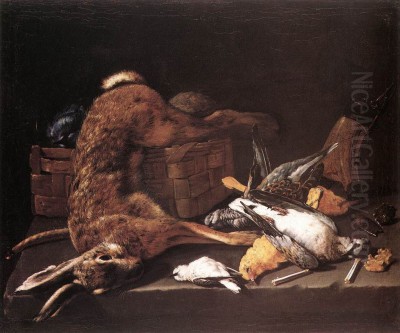
Giuseppe Recco (1634–1695) stands as a pivotal figure in the rich tapestry of Italian Baroque art, celebrated particularly for his mastery of still life painting. Born and primarily active in Naples, a vibrant artistic hub during the 17th century, Recco emerged from a family deeply rooted in the practice of painting. His works, characterized by their striking realism, complex compositions, and often opulent subject matter, captured the imagination of patrons both in Italy and beyond, securing his place as one of the leading specialists in the genre during his time. His legacy is intrinsically linked to the Neapolitan School, known for its dramatic intensity and naturalism, traits Recco skillfully adapted to the intimate world of still life.
Family Ties and Early Formation
Giuseppe Recco was born in Naples in 1634 into an environment steeped in art. His father, Giacomo Recco, was himself a respected painter, known for his flower pieces, providing Giuseppe with his earliest exposure to the craft. His uncle, Giovanni Battista Recco, also pursued painting, further solidifying the family's artistic identity. This familial background undoubtedly played a crucial role in shaping Giuseppe's path, offering him foundational training and an inherent understanding of the artistic milieu of Naples. Some accounts, notably by the art historian Bernardo de' Dominici, suggest a period in Recco's youth spent in Milan under the care of another uncle, Antonio Recco, though this remains somewhat anecdotal.
The most significant step in his formal artistic education was his apprenticeship in the workshop of Paolo Porpora. Porpora was a distinguished still life painter, himself influenced by Giacomo Recco and known for his detailed depictions of flowers, fruit, and notably, forest undergrowth and aquatic life. Working under Porpora allowed Giuseppe Recco to hone his technical skills and absorb the prevailing trends in Neapolitan still life, which blended local traditions with influences from Caravaggio's dramatic naturalism and Flemish precision. This training provided the bedrock upon which Recco would build his own distinct artistic personality.
The Essence of Recco's Style: Naturalism and Baroque Flair
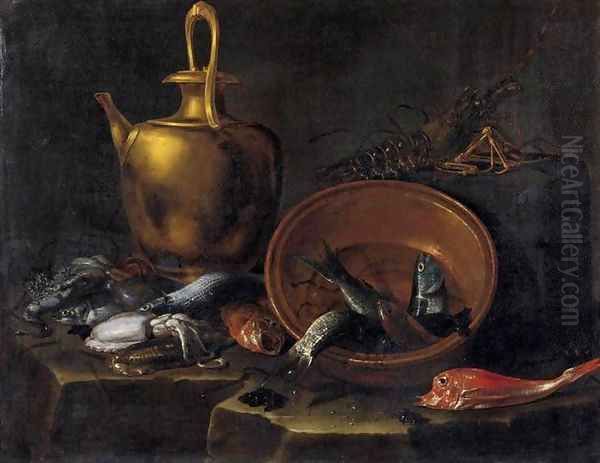
Giuseppe Recco's art is fundamentally rooted in naturalism, a faithful and detailed representation of the visible world. He possessed an extraordinary ability to render textures – the glistening scales of fish, the delicate petals of flowers, the rough skin of citrus fruits, the cool sheen of metalware. His subjects often appear intensely tangible, inviting the viewer to almost touch and feel the objects depicted. This commitment to realism connects him to the broader Caravaggesque current that swept through Naples, championed by artists like Jusepe de Ribera (Lo Spagnoletto), although Recco applied this intensity to the ostensibly quieter genre of still life.
However, Recco's naturalism is infused with the dynamism and theatricality characteristic of the High Baroque. His compositions are rarely static; instead, they are often complex, asymmetrical arrangements featuring diagonal lines, dramatic lighting (chiaroscuro), and a sense of abundance spilling towards the viewer. This Baroque sensibility distinguishes his work from the more austere still lifes of earlier Spanish masters like Juan Sánchez Cotán, aligning him more closely with the opulent Flemish tradition represented by artists like Frans Snyders or Jan Davidsz. de Heem, whose works were known and admired in Naples.
Light plays a crucial role in Recco's paintings. He masterfully manipulates light and shadow to model forms, create depth, and highlight specific textures, adding a layer of drama to his arrangements. His palette could range from rich, dark tones, particularly in his famous fish still lifes, to brighter, more vibrant colours in his depictions of flowers and fruit, demonstrating versatility and a keen sensitivity to the interplay of colour and light.
A Spectrum of Subjects: From Marine Life to Market Stalls
While adept across various still life subgenres, Giuseppe Recco is perhaps most renowned for his depictions of fish and other marine life. Naples, being a major port city, provided ample inspiration. His paintings of fish, often arranged artfully with copper pots, baskets, or simple kitchen implements, are celebrated for their almost startling realism. The wetness of the scales, the varied forms of sea creatures, and the interplay of light on their surfaces are rendered with exceptional skill. These works go beyond mere representation; they evoke the bustling atmosphere of the Neapolitan fish markets and the bounty of the Mediterranean Sea.
Beyond marine subjects, Recco excelled in painting arrangements of fruit and flowers. His floral pieces often showcase a variety of blooms, rendered with botanical accuracy yet arranged with Baroque exuberance. Similarly, his fruit still lifes capture the textures and colours of seasonal produce, often combined with glassware or ceramics. These works sometimes carry symbolic undertones, participating in the Vanitas tradition common in Baroque still life, where perishable items like flowers and fruit serve as reminders of the transience of life and earthly pleasures.
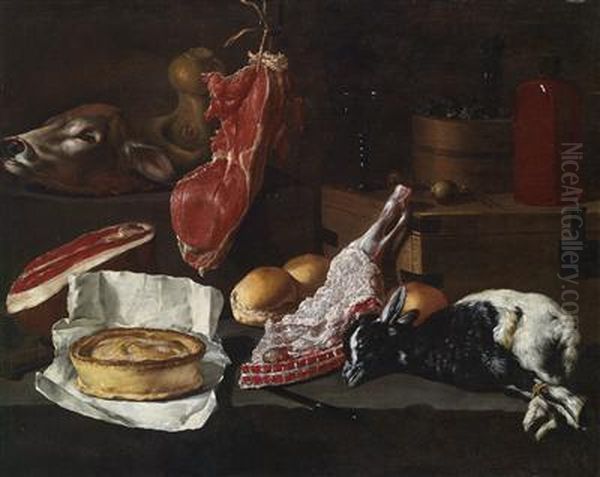
Recco also painted kitchen interiors and market scenes, often featuring a mix of foodstuffs, game, vegetables, and kitchenware. These paintings provide fascinating glimpses into the daily life and culinary habits of the period. The complexity of these compositions allowed Recco to demonstrate his skill in handling diverse textures and forms within a single canvas, creating visually rich and engaging narratives. His versatility extended to incorporating elements like shells, musical instruments, and luxurious fabrics into his compositions, reflecting the diverse tastes of his patrons.
Signature Works: Capturing Reality
Several key works exemplify Giuseppe Recco's artistry. His Still Life with Fish exists in multiple versions, showcasing his dedication to this theme. One notable example, housed in the Capodimonte Museum in Naples, presents a dynamic arrangement of various fish, their silvery scales catching the light, alongside simple earthenware. Another version, reportedly restored with funding from Ave College in Guimarães, Portugal, further attests to the popularity and dissemination of these compositions. These paintings are benchmarks of Neapolitan still life, demonstrating Recco's unparalleled ability to capture the essence of marine life.
Another significant work is the Still Life with Fruit, Flowers, and Vegetables, located in the Camera dei Deputati in Rome. This painting is particularly interesting for its complex composition, which includes not only an abundance of natural produce but also intriguing background elements like an ancient sarcophagus fragment, firearms, and an overturned female bust. This juxtaposition of the natural and the man-made, the perishable and the enduring, adds layers of meaning, possibly alluding to themes of life, death, and the passage of time, characteristic of sophisticated Baroque allegory.
His Kitchen Still Life paintings, often depicting arrays of copper pots, game birds, vegetables, and other provisions, are equally compelling. These works highlight his skill in rendering metallic surfaces and organizing complex, multi-object scenes into coherent and visually appealing compositions. They stand alongside similar works by contemporaries exploring kitchen and market themes, yet Recco brings his signature blend of realism and Baroque energy to the subject.
The Recco Workshop and Artistic Progeny
Like many successful artists of his time, Giuseppe Recco likely operated a productive workshop to meet the demand for his paintings. This workshop would have involved assistants and pupils who learned his style and helped produce works under his supervision. The family's artistic tradition continued through the next generation. His children, Nicola Maria Recco and Elena Recco, also became painters, specializing in still life and carrying forward the family name and, to some extent, the stylistic legacy established by Giuseppe and his predecessors, Giacomo and Giovanni Battista Recco.
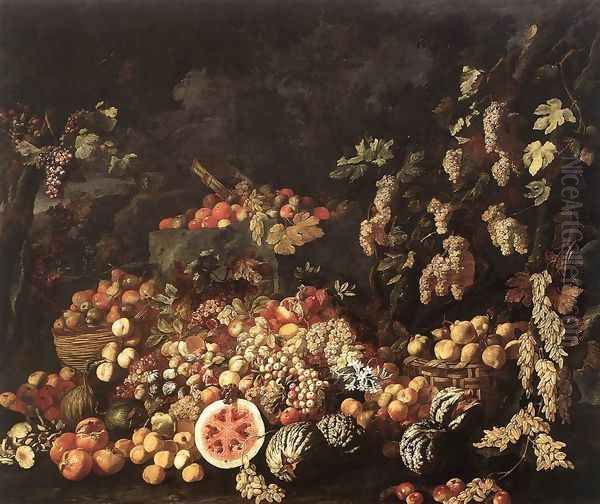
The existence of a family workshop contributed significantly to the proliferation of Recco's style and the overall prominence of still life painting in Naples. It ensured a consistent output and helped train younger artists, solidifying the Recco name as synonymous with high-quality Neapolitan still life. The workshop system was crucial in disseminating artistic styles and meeting the demands of a growing art market that included not only local nobility but also international collectors.
Naples: A Crucible of Artistic Exchange
Giuseppe Recco's career unfolded within the exceptionally fertile artistic environment of 17th-century Naples. Under Spanish rule, the city was a major European metropolis and a melting pot of artistic influences. The legacy of Caravaggio's visits in the early 1600s had left an indelible mark, fostering a powerful school of naturalistic painting led by figures like Jusepe de Ribera, Massimo Stanzione, and Bernardo Cavallino. Recco absorbed this prevailing taste for realism and dramatic lighting.
He worked alongside other prominent Neapolitan still life painters. Giovanni Battista Ruoppolo was a notable contemporary, also celebrated for his lush depictions of fruit and flowers, often displaying a similarly vibrant Baroque sensibility. While direct collaboration records might be scarce, the stylistic affinities suggest a shared artistic milieu and likely mutual awareness, if not influence. Andrea Belvedere, another Neapolitan specialist, continued the tradition of decorative flower painting into the later Baroque period.
Furthermore, Naples attracted artists from other regions. The Flemish painter Abraham Brueghel (grandson of Jan Brueghel the Elder) worked in Naples for a period, bringing with him the Northern European tradition of detailed and often opulent still life, which may have resonated with Recco's own inclinations. The dynamic and prolific Luca Giordano, Naples' leading painter in the later 17th century, though primarily known for large-scale narrative works, occasionally incorporated still life elements, and his energetic Baroque style permeated the city's artistic atmosphere. Mattia Preti, another major figure active in Naples before moving to Malta, also contributed to the city's reputation for powerful Baroque painting. The French flower painters Jean-Baptiste Monnoyer and Nicolas Baudesson, whose styles were known, represented another point of reference for floral compositions. Even the legacy of earlier Spanish bodegón painters like Francisco de Zurbarán might have indirectly informed the Neapolitan appreciation for starkly realistic still life.
Patronage, Reputation, and Spanish Connections
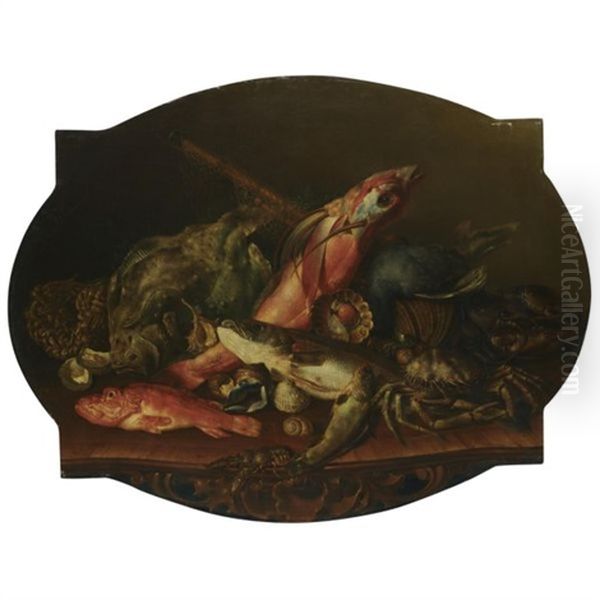
Giuseppe Recco achieved considerable success during his lifetime. His works were sought after by Neapolitan aristocrats, merchants, and clergy. Records indicate transactions with prominent collectors, such as the Duchess di Maddaloni Caracciolo, Sebastiano Giovane, and Francesco Antonio Celentano, demonstrating his established position within the local art market. His reputation extended beyond Naples, reaching other parts of Italy and international circles, particularly Spain, given the close political ties.
His fame eventually led to an invitation to the Spanish court. In the final years of his life, Recco traveled to Spain, a significant mark of recognition. He died in Alicante in 1695, reportedly while in service to the Spanish Crown. This final chapter underscores his high standing and the international appeal of his art, placing him among the Italian artists whose talents were sought by foreign rulers. His presence in Spain also highlights the continuous artistic exchange between Naples and Spain during this period.
Anecdotes and Lore
Art historical accounts, particularly those by Bernardo de' Dominici in his Vite de' Pittori, Scultori ed Architetti Napoletani (Lives of the Neapolitan Painters, Sculptors, and Architects), provide some colourful, though not always verifiable, details about Recco's life. The story of his youthful stay in Milan offers a glimpse into his early years away from Naples. More intriguingly, De' Dominici sometimes embellished accounts with anecdotes reflecting the perceived power of realistic art. While perhaps apocryphal, the notion mentioned in the source material that Recco's paintings were so lifelike they could provoke strong physical reactions speaks volumes about the contemporary admiration for his mimetic skill and the impact his works had on viewers.
The recurring theme of Vanitas in his work also adds a layer of intellectual depth often appreciated by Baroque audiences. The juxtaposition of abundance and decay, beauty and mortality, resonated with the spiritual and philosophical concerns of the era. Whether depicting glistening fish (potential Christian symbols) or wilting flowers, Recco's paintings often invited contemplation beyond their surface beauty.
Enduring Legacy: A Master of Still Life
Giuseppe Recco's contribution to art history lies in his elevation of still life painting within the demanding artistic environment of Baroque Naples. He synthesized the naturalistic tradition inherited from Caravaggism and his local predecessors with the dynamism and complexity of the High Baroque style. His specialization in marine subjects remains particularly noteworthy, capturing the essence of Naples' maritime identity with unparalleled verisimilitude and artistic flair.
He stands as a central figure in the Neapolitan School of still life, influencing subsequent generations, including his own children, Nicola Maria and Elena Recco, and potentially later artists like Baldassarre de Caro. His works continue to be admired in major museum collections worldwide, including the Capodimonte Museum in Naples, the Prado Museum in Madrid, the Uffizi Gallery in Florence, and the Getty Museum in Los Angeles, among others. They serve as enduring testaments to his technical brilliance, his compositional ingenuity, and his ability to transform everyday objects into compelling works of art.
Conclusion: The Vivid World of Giuseppe Recco
Giuseppe Recco navigated the vibrant artistic currents of 17th-century Naples to become one of its most accomplished and celebrated still life painters. Born into an artistic family and trained by a leading master, he developed a distinctive style that blended meticulous realism with Baroque dynamism. His depictions of fish, fruit, flowers, and kitchen scenes are remarkable for their tactile quality, skillful use of light, and complex arrangements. Through his prolific output and successful workshop, Recco not only achieved personal fame, reaching the Spanish court, but also significantly shaped the course of Neapolitan still life painting, leaving behind a legacy of works that continue to captivate viewers with their vivid portrayal of the natural world.